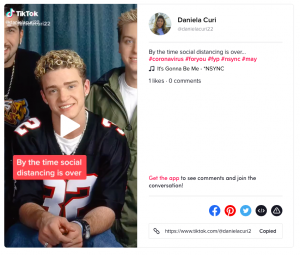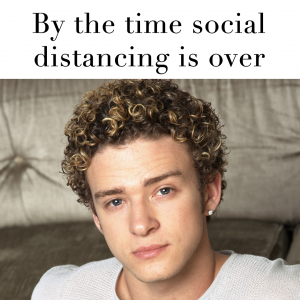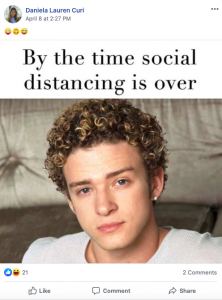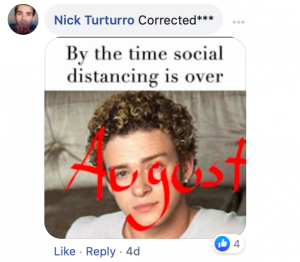Background
President Donald Trump announced on March 29th that he would be extending social distancing guidelines for at least another month, specifically until April 30th. The next time we could be outside and live a normal life again is possibly in May.
Every year when the month of May approaches, memes would surface on social media about NSYNC’s song It’s Gonna be Me. The lyrics would change to “It’s gonna be May” to play off the word ‘May.’ Below are examples:
Buckle up bois, it’s time for the “Its gonna be May” memes and gifs. Don’t waste this precious opportunity to share them all today #ItsGonnaBeMay pic.twitter.com/67Avtbj6AT
— Cydney ♡ (@cydneymorgan) April 30, 2019
Hyped for the “its gonna be May” memes tomorrow.. pic.twitter.com/khJi4IGD0e
— Rob Caiazzo (@robbbcc) May 1, 2019
April 14th…already seeing Its Gonna Be May Memes. 🤯
— CANDICE On Air (@CandiceOnAir) April 15, 2019
For the viral meme challenge, I decided to continue using the “It’s a Gonna Be May” meme and incorporate the possibility of social distancing ending in May. The meme relates to today’s current climate and can serve as people’s entertainment.
Objectives
Objectives have to be met in order for the meme to go viral:
- Earn 300 views on Imgur
- Gain over 100 social media engagements across Facebook, Twitter and Tik Tok, which includes likes, comments, shares, views, impressions, and retweets.
Analysis
1.Meme Creation
The creation of the meme needed crucial parts in order for online users to understand the NSYNC and social distancing reference – text and a photo of Justin Timberlake.
By adding the phrase, “By the time social distancing is over,” users could quickly identify the meaning without giving much thought. The photo of Justin Timberlake during his NSYNC era reminds people about the classic song and year “It’s Gonna Be May” memes.
After seeing how well the meme gained engagement, the usage of text and photo indicated that users were able to relate to the meme.
2. Imgur
The meme was posted on April 1st and was analyzed until April 12th. Besides the photo, other components needed to be considered and strategized for the goal of virality – hashtags.
I decided to look into trending hashtags on Imgur for a higher chance of the meme being seen. After researching the highest numbers of times certain tags were being used, #DistancingTogether, #Coronavirus, #Memes, and #SocialDistancing were ultimately selected.
Below is a chart that shows how many times each tag was specifically posted.
| Hashtag | # of Times Posted |
| #DistancingTogether | 1,968 |
| #Coronavirus | 35,327 |
| #Memes | 516,427 |
These hashtags were also chosen because each term related to the meme. Other hashtags, such as #JustinTimberlake, were also added to include the NSYNC reference and reach a niche audience.
The hashtag strategy helped the meme earn over 200 views in just a few days before being shared to Twitter and Facebook.
3. Twitter
The meme was tweeted on April 8th. According to Hootsuite, the best time to post on Twitter is from Monday to Wednesday between noon and 1 p.m.
By the time #socialdistancing is over 🙃 https://t.co/ikzopWmm5f
— D.C (@thedanielacuri) April 8, 2020
I decided to use the text that was already in the photo as a tweet and turned ‘social distancing’ into a hashtag. At first, I felt uncertain about the chance of people clicking on the link to view the content, since people would rather engage with content if it is at their convenience. However, the Twitter Activity feature showed the tweet earning 90 link clicks. What probably worked for the tweet were the hashtags.
Although, what could have earned the tweet more likes and comments were more hashtags, such as #coronavirus, #COVID19, and #NSYNC. The tweet only earned two likes.
4. Facebook
I made two posts on Facebook, but one post included the Imgur link and the other included just the photo. There were notable differences. Both were posted on Wednesday, April 8th between noon and 2 p.m. Hootsuite stated that the best times to post on Facebook were between 9 a.m. and 2 p.m. on Tuesday, Wednesday, or Thursday.
On April 8th, the meme was uploaded as a link and earned one like and one share. There were no hashtags used since Facebook is not big on that feature, unlike Twitter and Tik Tok. Furthermore, a Facebook friend of mine reached out to ask if my account was hacked. According to my friend, the post looked like spam and not a meme. After hearing her input, I decided to take a different approach.
An hour later, I decided to post the photo with no link. For the caption, I used emojis instead of text to prevent repetition. I also uploaded the photo to a Syracuse University Student Meme Facebook group. I made sure the photo followed the Facebook photo dimensions so users can easily see the content on their feed.
This strategy was used to reach a specific audience who regularly interacted with memes and to connect with my preferred audience that was decided in the marketing plan – college students.
This post turned out better than the one with the Imgur link. The photo earned 21 likes and a derivative post.
5. Tik Tok
 The popularity of the app influenced me to promote my meme as a video. In terms of when to post, Influencer Marketing reported that the best time to post on the app was during the evening; therefore, I posted after 6 p.m.
The popularity of the app influenced me to promote my meme as a video. In terms of when to post, Influencer Marketing reported that the best time to post on the app was during the evening; therefore, I posted after 6 p.m.
Many of Tik Tok’s videos are memes but in video form, so I turned my photo meme into a 15-sec video. By using some common Tik Tok video features, such as transitions and text, the new form of the meme gained over 100 views.
What also helped my video gained so many views were the hashtags that I selected – #coronavirus #foryou #fyp #nsync #may. These were trending on the explore page, which is great since my post is more likely to be viewed.
Results
The meme achieved the objective goals of earning over 300 views on Imgur and over 100 social media engagements across Twitter, Facebook and Tik Tok. As a result, the meme went viral.
Below is a chart that explains the analytics for each post.
| Engagements | Imgur | Tik Tok | ||
| Views | 604 | N/A | N/A | 163 |
| Likes | N/A | 2 | 21 | N/A |
| Dislikes | 11 | N/A | N/A | N/A |
| Comments | 7 | N/A | 2 | N/A |
| Impressions | 604 | 1,704 | N/A | N/A |
| Link Clicks | N/A | 90 | 21 | N/A |
| Shares | N/A | N/A | 1 | N/A |
What I learned that helped achieve the goal of virality were the importance of hashtags and research. Without these two factors, my meme wouldn’t have reached high engagement. Furthermore, the meme’s relevance to today’s current society helped connect with users.


